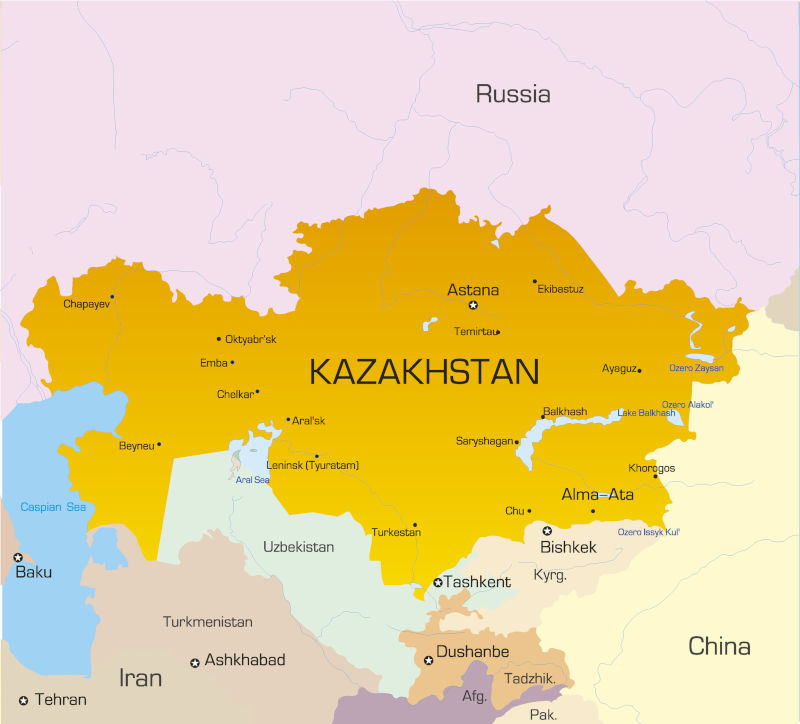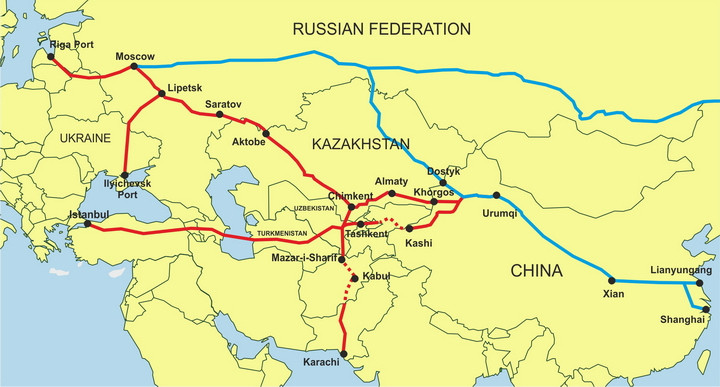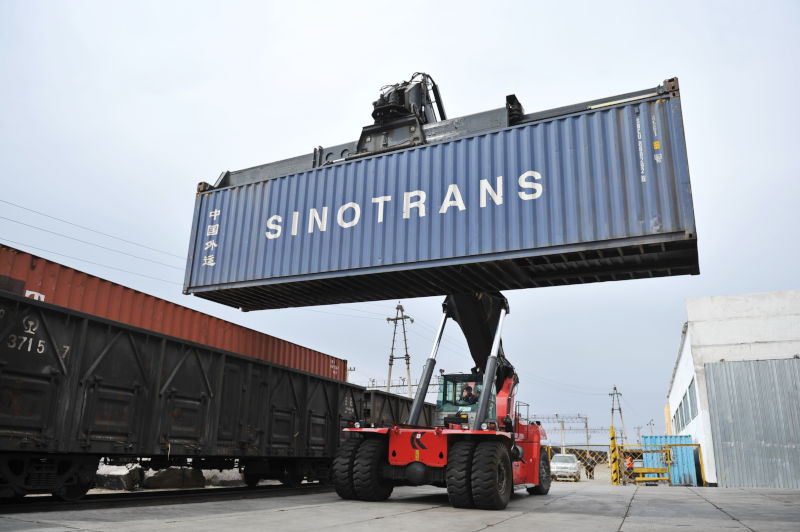Kazakhstan: The Belt & Road Highway To Europe & Central Asia
Kazakhstan will develop as a major Eurasian service center for continental trade and logistics
Op/Ed by Chris Devonshire-Ellis
Kazakhstan is the world’s largest landlocked country, and the ninth largest in the world. Sharing a 1,783 km border to the East with China, together with a slice of Western Mongolia, it also borders Russia to the north, and Kyrgyzstan, Uzbekistan, and Iran to the south. To the West, Kazakhstan meets the Caspian Sea. Apart from the Tian Shan mountain ranges between China and Kazakhstan, the country is mostly rolling steppe, making it one of the easier of the Central Asian nations to visit, and consequently receiving rather more Belt and Road Initiative attention than other Central Asian nations. It is also rich in mineral and gas deposits.
It is these geographical features and sheer longitude of Kazakhstan that make it such an important part of the Belt and Road Initiative – it gives access across Eurasia to the Caspian nations and onto Europe via both Russia and Turkey, minimizing national border controls and maximizing rail connectivity – Kazakhstan was born to have railways with kilometer after kilometer of track from east to west. That connectivity, stretching back to ancient silk road times have also helped Kazakhstan develop a more contemporary integration between East and West than its more ruggedly inaccessible southern neighbors, who are more traditional and conservative in their views. Modern Kazakhstan is largely contemporary – although it can still be wild in the far east on the Mongolian border – I have been out with the nomads there, riding horses and on one weekend, hunting with eagles on horseback. I once dated a Kazakh girl, and there is very little demand difference to Western standards and attitudes in the larger cities.
There are some issues – despite its vast size, Kazakhstan has a population of about 19 million – one of the lowest population densities in the world, at fewer than 6 people per square kilometer. That creates labor shortages and practical supply chain issues – including maintenance – as out in the steppe there are long distances to cover before one can find shops or enable repairs.

Kazakhstan is an upper-middle income, resource rich country, however its economy remains overly linked to energy supply and pricing. The halving of world oil prices and lower export demand since 2015 have resulted in a sharp slowdown with an average annual GDP growth rate of 2.2 percent between 2014-17. Growth picked up recently, although the Covid-19 pandemic and slump in commodity prices has again dented the growth outlook.
That means that Kazakhstan’s engagement with the Belt and Road Initiative and the exploitation of new infrastructure builds become of national importance. Although most global trade is carried by sea, rail is the second most important mode of international transport. Investments in rail and road increase competitiveness of both cross-border and domestic transportation in Central Asia. Two of the six BRI corridors pass through the region connecting China respectively to Europe and to Iran and West Asia. The northern route traverses Russia along the Trans-Siberian route and the INSTC, the southern one links China and Western Europe via Kazakhstan–Russia– Belarus– Poland–Germany. These transport corridors are not just for facilitating Chinese exports because for most of the Central Asian economies, China offers the closest port. That in turn makes Kazakhstan a huge potential hub for accessing Central Asia and means that the future for the country is not just the existing east-west trans-Kazakh China-European rail, but the development of spurs from that leading elsewhere.

The Kazakhstan-Kyrgyzstan-Kashgar Loop
The Kazak-Kyrgyz railway has existed since the Soviet era and connects Kyrgyzstan’s capital, Bishkek, to the Kazakh national rail network. It is currently being electrified which will vastly improve performance. Kyrgyzstan is also seriously considering a rail link from China’s Kashgar through to Osh and Bishkek. As and when this can be agreed and built, it will complete a looped rail circuit along which it would be possible to travel from Kashgar west to Kyrgyzstan, north to Kazakhstan, and east back to Urumqi and south again, returning to Kashgar.
Kazakhstan to Tajikistan
Access to Tajikistan hinges on whether China is willing to finance a rail link from Kyrgyzstan through to Tajikistan. A plan has been devised to build almost 50 tunnels and close to 100 bridges, with a total length of 500 km. connecting the two countries, which in turn would connect with the Kashgar loop in Kyrgyzstan I describe above. The line would traverse mountainous terrain, some sections over 3,000 meters above sea-level, with new construction of approximately 280km of track in Kyrgyzstan and about 180 km in China. The proposed line would run to Osh, a major trading city in Kyrgyzstan, and west into Uzbekistan. From Osh a spur would head south across the Kyrgyz-Tajik border to Dushanbe, the Tajik capital.
Kazakhstan to Pakistan
Landlocked Kazakhstan would benefit from seaport access. With rail connections already running through to neighboring Uzbekistan, the proposed Trans-Afghan railway would give Kazakhstan access to Arabian sea ports at Karachi and Gwadar and the ability to access Middle Eastern and South Asian markets.
The Caspian Connection
Kazakhstan is a Caspian sea nation and has been developing a huge freight and container Port at Aqtau. It is this facility that helps freight reach nearby markets on the Caucasus and onwards to Turkey and ultimately Europe via the BTK rail network. This rail network extends from Baku Port in Azerbaijan, to Georgia and Turkey, the shores of the Black Sea and markets to the European Union.
Kazakhstan is already extremely well placed to benefit from the Belt and Road Initiative, and this can be additionally enhanced, especially if the government can influence financing of these additional Central Asian rail networks and get them built. China, for its part, seems keen.

Changing containers from Chinese to Kazakh railway gauges at Almaty.
The Kazakh economy is the largest in Central Asia and its location is pivotal for the BRI. Notwithstanding a few gaps, its infrastructure is the most developed in the region. While the completion of BRI transport projects will lower Kazakh shipment time and increase FDI, non-oil exports and GDP, the bulk of that increase depends on trade facilitation and logistics reforms given the existing inefficiencies in border crossing.
Complementary reforms to liberalize FDI, lower trade restrictions, and remove constraints to growth in agriculture will help maximize the benefits. Policies that improve connections with Central Asian hinterlands, provide labor mobility and expand access to services across the country could reduce the spatial inequality that transport infrastructure investments typically generate. BRI’s support for cross-border transport infrastructure has benefited Kazakh connectivity.
The government has not used much of China’s available financing because as a land-locked country, it benefits from the easy availability of such financing for neighboring countries and the improvements in their transport network. Three of the BRI routes pass through Kazakh cities; two routes connect to Europe while the third transits through Uzbekistan and Turkmenistan to connect to Iran and West Asia, as well as to India using Iranian ports.
The regular train services on BRI corridor routes to Europe are frequent and reliable, with international and local logistics companies offering a growing range of more competitively priced services. The freight carried along these routes has already doubled in 2020 and look like doing so again.
The estimated decrease in shipment times and the rise in exports upon the completion of BRI transport projects will be magnified by trade facilitation and logistics reforms. BRI improvements in infrastructure reduce Kazakh shipment time by more than 8% and trade costs by 4%. But the size of that reduction could be two and half times greater if BRI transport projects are accompanied by reforms that halve border-crossing delays. That requires reforms at the Eurasian Economic Union level of which Kazakhstan is a founding member along with Russia, Armena, Belarus and Kyrgyzstan.
Some of the benefits of reduction in shipment time are already visible. Kazakhstan’s non-oil exports have grown in recent years, and the country has been attractive to foreign, including Chinese, investments in non-oil sectors. World Bank estimates also show that the BRI boost from a reduction in shipment time is much greater for non-oil exports. External demand for some of Kazakh exports (agriculture and processed foods, transport machinery and processed metals) is estimated to increase as their competitive production depends on time-sensitive imported inputs.

Rail tracks throughout continental Eurasia
Ensuring that exports respond to this will depend on those sectors attracting adequate foreign investors with the requisite technology to produce competitively and on the Kazakh government to implement complementary reforms that facilitate supply. The BRI can potentially have a large effect on GDP. The impact of improved infrastructure alone on Kazakh GDP is estimated at around 6.5%; while improving trade facilitation and reducing tariffs along the corridors will add around 9%.
As mentioned, some of these reforms involve the Eurasian Economic Union and agreements on customs treatment. These are now gaining some urgency as the member states seek to overcome the recent economic downturns and there are encouraging signs these changes may now be implemented.
The EAEU also has additional Free Trade Agreements with Iran, Serbia, Singapore, and Vietnam, while China has signed an agreement however s still in the process of agreeing tariffs. Other nations are known to be in discussions with the EAEU concerning FTA, including most of the ASEAN nations, Pakistan, Uzbekistan, Turkey, Israel, and Egypt, these will all boost Kazakh trade and investment when they come into effect.
As of April 2019, Kazakhstan has invested about US$30 billion on infrastructure development, transport and logistics assets and competence as part of the Belt and Road Initiative. Due to national infrastructure modernization, and intercontinental transportation routes, Kazakhstan stands to receive a potential U$5 billion annually in transit fees from goods moving through it to other markets. It is this new revenue stream that can be developed. Kazakhstan will transition from an agricultural and energy play to diversify by developing a service economy in transshipping, logistics, warehousing and added value manufacturing. Opportunities within these sectors will prove lucrative for investors.
Related Reading
- The Greater Eurasian Partnership: Connecting Central & South-East Asia
- Conquering The Mountains: Tajikistan And The Belt And Road Initiative
 Identifying Opportunities Within the Belt and Road Initiatives
Identifying Opportunities Within the Belt and Road Initiatives
About Us
Silk Road Briefing is written by Dezan Shira & Associates. The firm has 28 offices throughout Asia, and assists foreign investors into the region. For strategic advisory and business intelligence issues please contact the firm at silkroad@dezshira.com or visit www.dezshira.com






